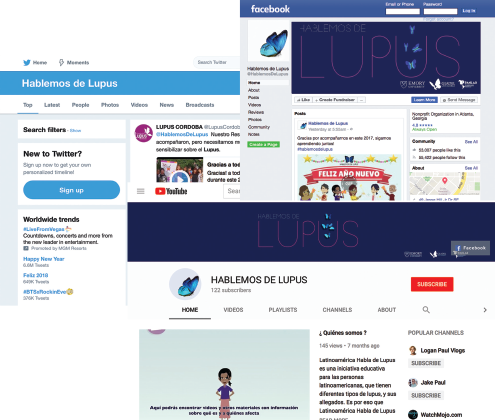A person living with lupus may feel isolated. They receive information from their doctor, but it’s never enough to fully understand the disease. So where do they turn? Social media, where they can connect, share information and learn.
A new social media initiative, Hablemos de Lupus—which translates to Let’s Talk About Lupus—focuses on sharing accurate lupus information with Spanish-speaking patients in Latin America. The focus on Latin America ties in with the proportionally larger number of Latino patients with lupus than non-Latinos. Research shows that a lupus diagnosis usually takes longer to confirm in Latinos than in non-Latinos and the disease tends to be more severe among Latinos.
“Hablemos de Lupus is part of a comprehensive project that aims to bridge a longstanding gap in the provision of appropriate and scalable health education to the Latin American population with lupus,” says Cristina Drenkard, MD, PhD, an associate professor of medicine in the Division of Rheumatology at Emory School of Medicine, Atlanta, who leads the initiative. “The first stage of this initiative targets the Spanish-speaking population with lupus and their caregivers.”
Funded by a 2017 International League of Associations for Rheumatology grant, Hablemos de Lupus uses social media as its main vehicle. Its Facebook page has the largest concentration of users, but it also fields a YouTube channel and a Twitter account.
“The social channels provide a safe community where patients can learn from evidence-based content, express themselves, ask [experts] questions and open discussions around lupus with others,” Dr. Drenkard says.
Facebook appears key, says Celeste Eberhardt, social media specialist for Hablemos de Lupus. “Most people have Facebook access and connect to it often. … I was shocked by how relieved people were to see others going through similar experiences,” Ms. Eberhardt says.
The Content
Topics covered on Hablemos include general education about lupus and living better with lupus. Videos that last just a couple of minutes and short messages can convey evidence-based information. The group creates its content with the needs and health literacy levels of the audience in mind, Dr. Drenkard says.

Lupus sufferers can check out Hablemos de Lupus on Twitter, Facebook and YouTube.
There’s a special focus on making the videos easy for people to understand, so they aren’t too complex, Ms. Eberhardt says. Videos posted include: “What Is Lupus?” “What Is an Antibody?” and “Exercising with Lupus.” Followers can ask questions, and a team of Hablemos rheumatologists answer within 24 hours.
“Hablemos de Lupus does not address specific diagnosis or treatment recommendations,” Dr. Drenkard says. “Our responses provide general information about the topics raised and encourage participants to discuss their questions with their physicians.”
The information users obtain through Hablemos de Lupus is meant to complement what they get from their doctors. It doesn’t replace in-person meetings with fellow patients or doctor visits.
A multidisciplinary team of lupus experts and rheumatologists, lupus education groups, patients and caregivers work with the initiative, in addition to a social media specialist, a creative producer and a webpage specialist. The rheumatologists are members of the Latin American Group for the Study of Lupus (GLADEL), an organization of nearly 90 rheumatologists from 36 centers across nine Latin American countries.
Hablemos also posts monthly live videos featuring a lupus expert. One recent live video discussed lupus and the kidneys. Led by an Argentinean rheumatologist, that video reached a peak of roughly 500 live views. “After 48 hours, there were 21,000 video views, over 4,000 reactions, 560 comments and nearly 700 shares,” Dr. Drenkard says.
More Numbers
User numbers reveal the need for Hablemos de Lupus. After launching in early May 2017, Hablemos has amassed more than 50,000 Facebook followers, Dr. Drenkard says. People follow from every Latin American country, but most live in Mexico, Peru and Argentina. The page has also drawn followers from the U.S., Europe and Asia.
The initiative’s first YouTube video, “What Is Lupus?” (see below), recorded 3.3 million views in its first week and reached more than 14 million people within a month. “It’s a very clear sign this is something people want more information about,” Ms. Eberhardt says.
The average Facebook reader rating for Hablemos is currently 4.8 stars out of 5, compiled from roughly 300 reviews.
“Hablemos de Lupus is a low-cost, innovative model of health education and patient empowerment proven to be effective in reaching … a huge audience in a short time, which would be unrealistic through in-person meetings,” Dr. Drenkard says.
The Users
A diverse group of users across Latin America—from patients to their family members—connect and share their stories via Hablemos de Lupus. One example: Glenda Chávez of San Salvador, El Salvador. Ms. Chávez was diagnosed with lupus 10 years ago and has organized a group of roughly 70 people with lupus in her country around a Facebook page called Lupus El Salvador. Hablemos de Lupus and Ms. Chávez’ group help provide support and information in a country with very few rheumatologists and few resources to make lupus more understandable, Ms. Chávez says.
Ms. Chávez says Hablemos de Lupus is the official “fountain of information” for her group. The information shared on Hablemos helps answer common questions, including the foremost: “Am I going to die from this soon?” The information shared focuses on better self-care, something that can take time for those newly diagnosed with lupus to understand.
Another user: Laura Athié of Puebla, Mexico, who was diagnosed with lupus in 2000 (although her symptoms started much earlier than that). Ms. Athié regularly interviews other people with lupus and has even had a tango-lupus therapy dance she created performed at a doctors’ meeting. Hablemos de Lupus has given Ms. Athié a place to meet others with lupus and share and learn new information.
Ms. Athié says Hablemos de Lupus can help answer questions many people have about lupus, such as what the disease is, complications, whether a woman with lupus can still get pregnant, information on sun exposure sensitivity and more. And, she says, the YouTube videos educate patients without scaring them.
Ms. Athié believes people are more willing to ask questions on Hablemos de Lupus than if they were in a large in-person setting. “There are no barriers on Hablemos de Lupus,” she says.
Future Expansion
Eventually, Hablemos de Lupus plans to tackle Portuguese so it can expand to Brazil. The investment required to expand there should remain low, because the group’s existing content is relevant for the audience. “In addition to the Portuguese translation of videos already posted in Hablemos de Lupus, we plan to create videos and other types of educational resources on topics … using input from Brazilian patients, providers and social communicators,” Dr. Drenkard says.
The group plans to build a website as well, says Dr. Drenkard. It will host educational material in Spanish and Portuguese.
It’s for You, Too
All rheumatologists with Spanish-speaking patients—including those in the U.S.—can lean on Hablemos’ social media channels. If a rheumatologist faces difficulty fully explaining how to self-manage the disease due to a language barrier, they can refer patients to Hablemos de Lupus. “Language barriers and health literacy are additional obstacles faced by U.S. providers, particularly those who serve socioeconomically disadvantaged Hispanic populations,” Dr. Drenkard says.
Vanessa Caceres is a medical writer in Bradenton, Fla.
ACR, Lupus Foundation Target at-Risk Women
A new online awareness campaign, called Be Fierce. Take Control., targets African American and Latino women aged 18–25, who are most at risk for developing lupus. Jointly created by the ACR and the Lupus Foundation of America (LFA), the campaign encourages women not to ignore possible symptoms of lupus, such as fatigue and joint pain. The campaign also addresses the importance of early diagnosis and treatment in helping reduce the disease’s long-term consequences.
Still, the campaign aims to educate people without scaring them about the symptoms, says Stacey Boyd, senior communications manager of collaborative initiatives for the ACR. The look of Be Fierce. Take Control. appeals to a younger audience; even the background colors were tested with the target audience, Ms. Boyd says.
The campaign uses social media, video, digital advertising and audience engagement to educate viewers about the signs and symptoms of lupus. The videos lead viewers to the campaign’s website, which provides information and resources from both the ACR and LFA about lupus symptoms, and what next steps to take if someone thinks they have lupus.
Some of the campaign’s social media assets have been shared by celebrities on their social media channels, including musical artists Lil Wayne and Young Money, as well as actor Ashton Kutcher and ESPN sports analyst Maria Taylor, Ms. Boyd says.
Funded by a Centers for Disease Control and Prevention grant, the campaign launched last June.

